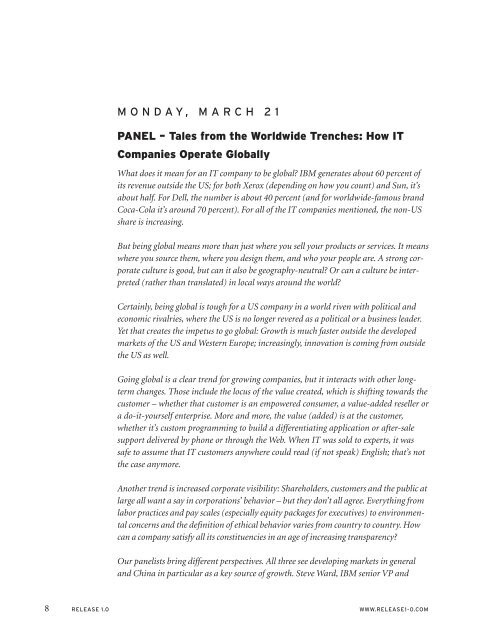The World Wide World: IT Ain't Just the Web ... - Cdn.oreilly.com
The World Wide World: IT Ain't Just the Web ... - Cdn.oreilly.com
The World Wide World: IT Ain't Just the Web ... - Cdn.oreilly.com
Create successful ePaper yourself
Turn your PDF publications into a flip-book with our unique Google optimized e-Paper software.
MONDAY, MARCH 21<br />
PANEL – Tales from <strong>the</strong> <strong>World</strong>wide Trenches: How <strong>IT</strong><br />
Companies Operate Globally<br />
What does it mean for an <strong>IT</strong> <strong>com</strong>pany to be global? IBM generates about 60 percent of<br />
its revenue outside <strong>the</strong> US; for both Xerox (depending on how you count) and Sun, it’s<br />
about half. For Dell, <strong>the</strong> number is about 40 percent (and for worldwide-famous brand<br />
Coca-Cola it’s around 70 percent). For all of <strong>the</strong> <strong>IT</strong> <strong>com</strong>panies mentioned, <strong>the</strong> non-US<br />
share is increasing.<br />
But being global means more than just where you sell your products or services. It means<br />
where you source <strong>the</strong>m, where you design <strong>the</strong>m, and who your people are. A strong corporate<br />
culture is good, but can it also be geography-neutral? Or can a culture be interpreted<br />
(ra<strong>the</strong>r than translated) in local ways around <strong>the</strong> world?<br />
Certainly, being global is tough for a US <strong>com</strong>pany in a world riven with political and<br />
economic rivalries, where <strong>the</strong> US is no longer revered as a political or a business leader.<br />
Yet that creates <strong>the</strong> impetus to go global: Growth is much faster outside <strong>the</strong> developed<br />
markets of <strong>the</strong> US and Western Europe; increasingly, innovation is <strong>com</strong>ing from outside<br />
<strong>the</strong> US as well.<br />
Going global is a clear trend for growing <strong>com</strong>panies, but it interacts with o<strong>the</strong>r longterm<br />
changes. Those include <strong>the</strong> locus of <strong>the</strong> value created, which is shifting towards <strong>the</strong><br />
customer – whe<strong>the</strong>r that customer is an empowered consumer, a value-added reseller or<br />
a do-it-yourself enterprise. More and more, <strong>the</strong> value (added) is at <strong>the</strong> customer,<br />
whe<strong>the</strong>r it’s custom programming to build a differentiating application or after-sale<br />
support delivered by phone or through <strong>the</strong> <strong>Web</strong>. When <strong>IT</strong> was sold to experts, it was<br />
safe to assume that <strong>IT</strong> customers anywhere could read (if not speak) English; that’s not<br />
<strong>the</strong> case anymore.<br />
Ano<strong>the</strong>r trend is increased corporate visibility: Shareholders, customers and <strong>the</strong> public at<br />
large all want a say in corporations’ behavior – but <strong>the</strong>y don’t all agree. Everything from<br />
labor practices and pay scales (especially equity packages for executives) to environmental<br />
concerns and <strong>the</strong> definition of ethical behavior varies from country to country. How<br />
can a <strong>com</strong>pany satisfy all its constituencies in an age of increasing transparency?<br />
Our panelists bring different perspectives. All three see developing markets in general<br />
and China in particular as a key source of growth. Steve Ward, IBM senior VP and<br />
8 RELEASE 1.0 WWW.RELEASE1-0.COM
















